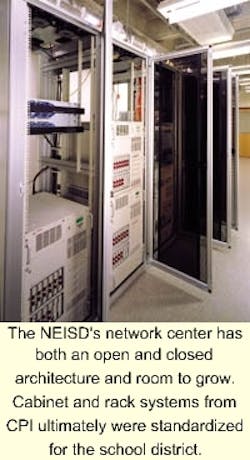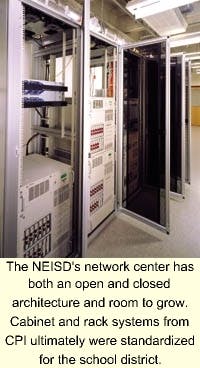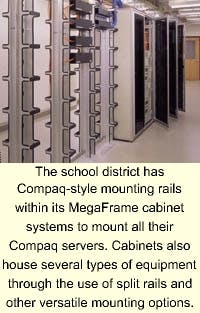Technology sent to the principal's office
Bryan Melamed / Chatsworth Products Inc.
A Texas school district transformed ex-military center into a wired learning environment.
Any school that takes over a major Air Force data center and uses it for its own network has to be serious about data communications. A case in point is the San Antonio, TX, North East Independent School District (NEISD), which has spent $250,000 on cabling alone to bring technology into the classroom for students and teachers alike.
With 53 schools spread out over 140 square miles, the NEISD, thanks to an all-encompassing information-infrastructure upgrade, is now embraced by a single enormous Ethernet local area network (LAN) with wide-area-network (WAN) capabilities. The LAN currently includes thousands of individual nodes and hundreds of subsidiary distribution hubs, typically at least 15 per high school. Every school in the NEISD is now equipped with a high-speed Internet connection via a 1.554-Mbit/sec T1 leased line or a direct fiber-optic link. Video drops are also deployed throughout the network, and a comprehensive video-on-demand system is currently in the planning stage.
Located within the heart of the south Texas high-technology belt, the NEISD is determined to provide its students with the skills to take their places within the rapidly expanding electronic communications industries that have made the region second only to Silicon Valley in technical innovation and creation of new wealth. The citizens of the NEISD have consistently voted for the bond issues that finance the tens of millions of dollars in expenditures on computers and networking devices that provide every classroom with advanced distance-learning capabilities. These measures often pass by a 70% or better margin. With adequate funding in place, improvements to the network are ongoing.
Within the educational sphere, the network serves multiple purposes. Notes Steven Emilienburg, executive director of management information services (MIS), "We can provide training, conduct meetings, store and retrieve personnel files, and enter daily attendance," citing some of the network's purely administrative functions. But increasingly, the network has come to assume a major instructional role by providing educational materials directly to the students - primarily text at this point, but the district expects to incorporate multimedia within a year.
Overachieving district-wide network
By the early 1990s, the NEISD had many computers in the classrooms but virtually no access via computer to shared information resources. Says Brian Combs, Austin regional director for OTM Engineering (Austin, TX), "A couple of the high schools had LANs of their own, but there was no centralized network. We were literally starting at ground zero." OTM Engineering designed the wiring component of NEISD's network.
In 1995, NEISD management decided to address the lack of data connectivity and presented a bond issue to the citizenry to finance initial construction of what was to eventually become a district-wide network. The voters approved the idea, and the design contract was awarded to OTM Engineering.
The NEISD has its own information-services department, including network director in charge of overall policy, Mike Chicoine, and Unix system administrator, Dave Caron. The two have collaborated with OTM Engineering to arrive at the network's overall design.
"To an extent, they already knew what they wanted," recalls Combs. "They wanted a high-speed Internet connection to every classroom. This was a pretty radical idea five years ago, and they had already decided on a lot of the equipment for the network. They were set on Compaq servers, for one thing, and we built that equipment requirement right into the installation specification."
"We wanted uniformity," says Caron, discussing the genesis of the district network, "and at the same time, we wanted centralized administration. Everything had to go back to a single hub, and all of the spokes of the network had to be similar."
Adds Emilienburg, "We want new schools to have the best equipment, and we want old schools to have the same - no easy task, since new construction and old construction present different issues, especially when retrofitting what would ultimately become a new cabling infrastructure."
The plan, as it was eventually expressed in the official document sent to the bidders, was to start with a fully functional hub and incrementally add individual school subnets so the benefits of networking would be made available to the NEISD almost immediately. The district had previously bought a new administration building and had a technology infrastructure in place.
"The district acquired the building that housed an impressive Air Force data center and the Resolution Trust Corp. [the organization involved in settling the debts of failed savings and loan institutions]," recounts Caron. "The whole building was very well equipped - raised floor, plenty of conduit for cabling, restricted access, the whole nine yards. We ended up consolidating everything into one room measuring 60 ft by 45 ft."
The NEISD was able to set up the main hub at least partially with legacy facilities, but the schools themselves required that distribution frames be built literally from the ground up, since network equipment was not in place at the level of individual schools.
From brand new to decades old
The NEISD itself was rapidly expanding at the time, with ongoing construction of new schools. This situation allowed the planners the luxury of designing spaces to accommodate the new hardware. But the older schools, of course, required reconstruction and, in most cases, had to make do with available spaces. "Nobody had envisioned network centers when the older schools were built," notes Caron, "and we had to deal with all kinds of rooms, some of which were really too small."
He says that in the case of intermediate crossconnect (IC) rooms, the district sometimes ended up putting equipment in locked closets for want of any other place. "It was a real challenge," he recalls. "There was a lot of retrofitting, and the actual installation work, along with the building construction, was being done by a lot of different contractors. Fortunately, Brian Combs, the OTM partner who headed the project, was very good at coordinating. It helped that we were able to specify the rack system from Chatsworth Products Inc. [CPI] for most of the schools. Their cable-management capabilities really helped, especially where space was at a premium."
Combs, who served as project manager for the NEISD design and construction, vividly recalls the travails of installing infrastructure within construction that varied from brand new to decades old. "The new construction was not too bad, because we could prewire, but we had to get creative with the older stuff. A lot of the schools had solid concrete walls on concrete slab, so we had no choice but to install surface-mounted raceways to carry the cable."
The NEISD plan called for the provision of equivalent networking capabilities to all of its schools, although high schools received higher-speed networks than middle or elementary schools. Installation work commenced in April 1997 and was largely completed by the end of 1999. Three schools are currently slated for completion, which will finish the five-year-long project.
Network takes form
With potentially hundreds of users per school, the network had to permit the reuse of bandwidth. The NEISD's IS department never seriously considered anything other than switched Ethernet.
The district also favored a highly distributed deployment of network resources with multiple switches assigned to every school. Each school would constitute a secondary network hub, a main crossconnect (MC), and a number of ICs. Local servers would be concentrated at the MCs, while ICs contain only switching equipment. Very-large-capacity servers with redundant arrays of inexpensive discs (RAID) would occupy the central hub for the whole district.
The NEISD itself selected much of the equipment for the network subcenters - one 3Com Corebuilder 3500 layer-three switch for each of the MCs, two to four Compaq Proliant 6000 servers running Novell Netware Version 5 in each of the MCs as well, and one 3Com Corebuilder 10/100 autosensing switch for each of the ICs. The basic equipment complement remains unchanged, regardless of the type of school, but high school networks run at 100-Mbit/sec Fast Ethernet speeds, as opposed to the 10-Mbit/sec Ethernet speeds at which elementary and middle schools operate. Furthermore, all school MCs contain an additional piece of equipment, namely an IBM RS6000 server for Proxy/DHCP services.
All ICs communicate back to their assigned MCs, while MCs, in turn, communicate back to the central NEISD data hub. The NEISD hub provides Internet connectivity to the entire district and provides a gateway for each of the schools.
With the exception of a handful of schools representing the first installations, all facilities use CPI's rack system exclusively, deploying MegaFrame cabinet systems with lockable glass doors in the MCs and swing-gate racks in the ICs. In addition, both hubs use CPI's ladder racks for cable routing.
"Before choosing an infrastructure vendor, we drew up a list of qualifications, then we took some time to ask around and do some investigating on our own," says Combs. "We ultimately standardized on the CPI systems approach, which afforded both closed and open architectures, combined with quality and reasonable pricing. Then we just wrote CPI's products into the standard. Several hundred were eventually purchased."
Though the district network is complex in terms of the sheer number of network components it contains, Combs found the design of the cabling to pose greater challenges. "We had to design the entire physical transport layer and then oversee the installation," he adds.
OTM Engineering wanted a cable plant that was as future-ready as possible and extremely low maintenance. The NEISD wanted the same. "We specified a 15-year warranty for the cable plant, which would include both connectors and the cable itself," says Combs. "We ended up going with CommScope [Claremont, NC] cable and Leviton Telcom [Bothell, WA] connectors for both the optical and copper portions of the network."
Because the individual networks were installed in stages that encompassed a number of construction phases, the cabling installations are not absolutely identical. Almost all schools have fiber connections from the ICs to MCs and, in some cases, from the MC to the central hub. Internal fiber connections are 24-, 36-, and 48-strand multimode fiber, while WAN connections will soon take place over leased fiber. Connections from the ICs to the individual classrooms are over Category 5 copper cable, as are the phone connections, which OTM also specified. A separate network of coaxial cable distributes cable-TV programming to every classroom.
"Eventually, we'll have fiber for all the major connections in the network," predicts Caron. "The phones will continue to use Category 5 cable, but that's about it."
Why all the fiber? "Eventually the network will be capable of true radio and video-on-demand," Caron explains. "Content will be centrally stored and transmitted everywhere in the system. It will also be able to do live streaming media. The current cabling infrastructure provides the foundation for the more-advanced content delivery system of the future. That's why we went to so much trouble to do it right."
Bryan Melamed, RCDD, is product manager at Chatsworth Products Inc. (Westlake Village, CA).


